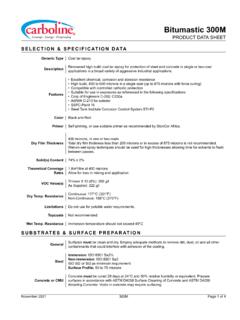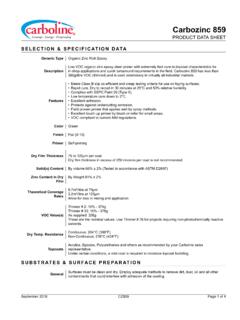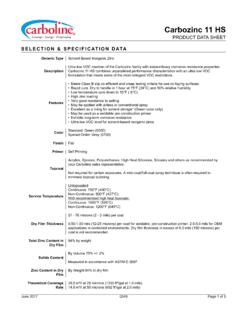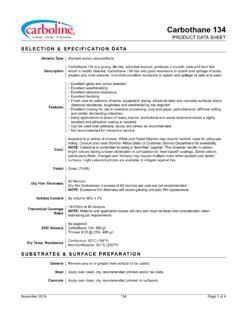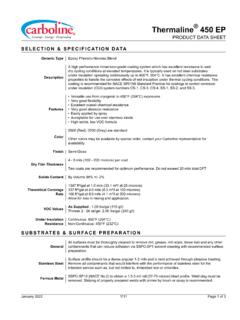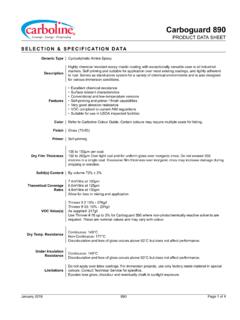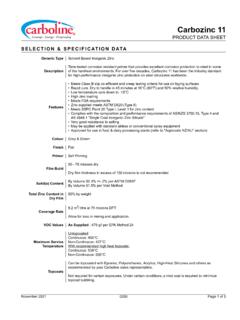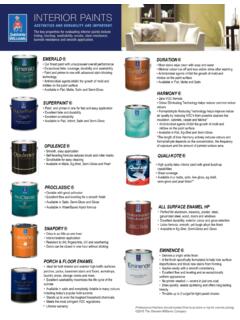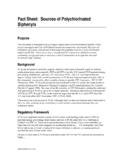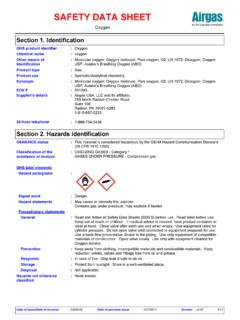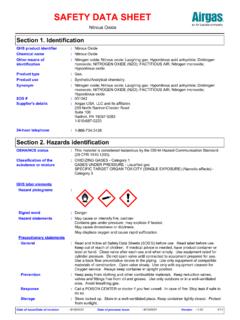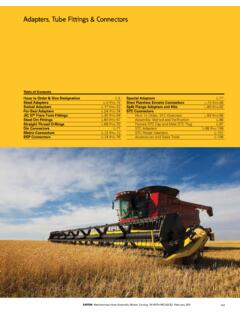Transcription of Carboguard 635 - Carboline
1 Carboguard 635 PRODUCT DATA SHEET January 2020C635 Page 1 of 4 SELECTION & SPECIFICATION DATA Generic TypeCross-linked epoxy polymeric amine DescriptionAn all-purpose immersion-grade epoxy that has a variety of attributes including low-temperaturecure, surface tolerance, fast recoat times, moisture tolerance during application and cure, andexcellent corrosion protection. Can be used direct to metal as a corrosion resistant primer or asan intermediate coating over other primers. Suitable for both maintenance and new constructionprojects due to its excellent surface wetting characteristics and quick cure for handling. May also beused for immersion in potable water , fresh or salt water (marine) exposures.
2 Features Low temperature cure Excellent corrosion protection Excellent application characteristics Fast recoat times Moisture tolerance during application Extended recoat window for atmospheric exposures (6 months for most topcoats) ColorPotable water Use: (0200) Beige, (0700) Grey and (0800) WhiteOther Colours: Red and Black GlossSatin PrimerSelf-priming RecommendedThickness100 to 150 microns per coat Solid(s) ContentBy Volume: 65% 2% Theoretical /litre at 25 /litre at 100 /litre at 150 micronsAllow for loss in mixing and application. VOC Value(s)Thinned 8% with Thinner # 76: 337 g/litreAs supplied: 296 g/litre (mixed)These are nominal values and may vary with colour Dry Temp.
3 ResistanceContinuous: 82 C (180 F)Non-Continuous: 104 C (219 F) ApprovalsPotable water Use Limitations at 23 C:Max DFT: 300 micronsNumber of coats: 2 (150 microns per coat)Cure between coats: 45 minutesRating: >3000 gal (tank) LimitationsEpoxies lose gloss, discolour and eventually chalk in sunlight exposure. TopcoatsMay be coated with Acrylics, Epoxies, Alkyds, Polyurethanes or Polysiloxanes, depending onexposure and 635 PRODUCT DATA SHEET January 2020C635 Page 2 of 4 SUBSTRATES & SURFACE PREPARATION GeneralRemove any oil or grease from surface to be coated with clean rags soaked in Carboline Thinner #2. SteelAtmospheric Exposure: For optimal performance, hand tool or power tool clean in accordancewith SSPC-SP2, SSPC-SP3 or SSPC-SP11 to produce a rust-scale free maximum performance, SSPC-SP6 (or greater) with a 40 to 75 micron blast Service: White metal cleanliness in accordance with SSPC-SP10 minimum.
4 Galvanized SteelGalvanising requires a roughened surface for optimum adhesion / performance of high buildepoxies. Remove any contaminants per SSPC-SP1; ensure there are no chemical treatments thatmay interfere with adhesion; and abrade the surface to establish a suitable roughness (typically 25microns). SSPC-SP7 or SP11 are acceptable methods. Concrete or CMUR emove all loose, unsound concrete. Remove all oils or other non-compatible sealers ortreatments. Do not apply coating unless the concrete has cured at least 28 days at 21 C and 50%relative humidity or equivalent. Stainless SteelSurface profile should be a dense angular 25 to 75 m and is best achieved through abrasiveblasting.
5 Remove all contaminants that would interfere with the performance of stainless steel forthe intended service such as, but not limited to, imbedded iron or & THINNING MixingMix separately, then combine and mix until homogenous. ThinningFor atmospheric applications, thin up to 8% by volume with Carboline Thinner # 76, or 8% byvolume with Carboline Thinner # 33 for brush and roller. For immersion (including potable water ),use Thinner # 38 up to 8% by volume. Ratio4:1 (Part A : Part B) Pot Life3 Hours at 24 C and less at higher temperatures. Pot life ends when coating becomes too viscousto EQUIPMENT GUIDELINES Listed below are general equipment guidelines for the application of this product.
6 Job site conditions may require modificationsto these guidelines to achieve the desired results. Conventional SprayPressure pot equipped with dual regulators, 3/8" minimum material hose, " fluid tipand appropriate air cap. Airless SprayPump Ratio: 30:1 (min)Volume Output: l/minMaterial Hose: 3/8" min (905 mm)Tip Size: to "Fluid Pressure: 2000 to 2500 psiNOTE: PTFE Packings are recommended and available from pump manufacturer. Brush & Roller(General)For applications over damp surfaces, brush and roller is the preferred method. Multiple coats maybe required to obtain desired appearance, recommended dry film thickness, and adequate excessive re-brushing or re-rolling.
7 For best results, tie-in within 10 minutes at 24 C. Use ashort nap synthetic roller cover with phenolic 635 PRODUCT DATA SHEET January 2020C635 Page 3 of 4 APPLICATION CONDITIONS ConditionMaterialSurfaceAmbientHumidityM inimum7 C (45 F)-7 C (19 F)-7 C (19 F)0%Maximum32 C (90 F)49 C (120 F)38 C (100 F)95% Industry standards are for substrate temperatures to be above the dew point. Carboguard 635 is unique in that it can toleratedamp substrates. See Brush or Roller above. Special thinning and application techniques may be required above or below SCHEDULE Surface to HandleDry to TouchDry to TopcoatMinimumDry to TopcoatMaximum-7 C (19 F)36 Hours4 Hours24 Hours180 Days2 C (36 F)16 Hours2 Hours2 Hours180 Days10 C (50 F)10 Hours1 Hour1 Hour180 Days24 C (75 F)3 Hours30 Minutes45 Minutes180 Days32 C (90 F)30 Minutes15 Minutes30 Minutes180 Days These times are to be used as a listed times in the chart above are based on a 100 to 150 micron dry film thickness per coat.
8 Deviation from those thicknessesmay compromise the performance and adhesive properties of the film. Higher film thickness, insufficient ventilation or coolertemperatures could result in solvent entrapment and premature failure. Excessive humidity or condensation on the surface duringcuring will not affect performance, but may cause discoloration and result in a surface haze. Any haze or blush must be removedby water washing before recoating. If the maximum recoat times have been exceeded, the surface must be abraded by sweepblasting or sanding prior to the application of additional coats. For force curing, contact StonCor Africa Technical Service forspecific requirements.
9 Do not apply to substrates with ice or ice crystal formation. Dehumidify or raise the temperature to eliminateice on the substrate. This product will tolerate drops in temperature to -17 C during its cure and will continue to cure when thetemperature rises. Follow "Cure for Service" guideline listed above to determine when the product is fully Use:Undocking time of 24 hours at 24 C: The optimum time to topcoat with an antifoulant is when the Carboguard 635 is "touch-tacky". If the touch-tacky time has been exceeded, or if the film is "glossy", you can generally re-prime / refresh the first coat ofCarboguard 635 with a fresh coat of itself within 30 days.
10 The longer the first coat has to cure, particularly in sunlight exposureor elevated temperatures, the higher the risk of inadequate adhesion. If those maximum recoat times have been exceeded, thesurface must be abraded by sweep blasting or sanding prior to the application of additional topcoat time for atmospheric use: 180 daysCure for potable water use: 7 Days cure after final coat at 23 C. Surface to Topcoat MinimumDry to Topcoat withAntifoulant MaximumDry to Topcoat with Itself-7 C (19 F)24 Hours36 Hours30 Days2 C (36 F)2 Hours16 Hours30 Days10 C (50 F)1 Hour8 Hours30 Days24 C (75 F)45 Minutes4 Hours30 Days32 C (90 F)30 Minutes3 Hours30 Days The curing schedule above references curing times for immersion service when an antifoulant topcoat is optimum time to topcoat with an antifoulant is when the film is "touch-tacky".

